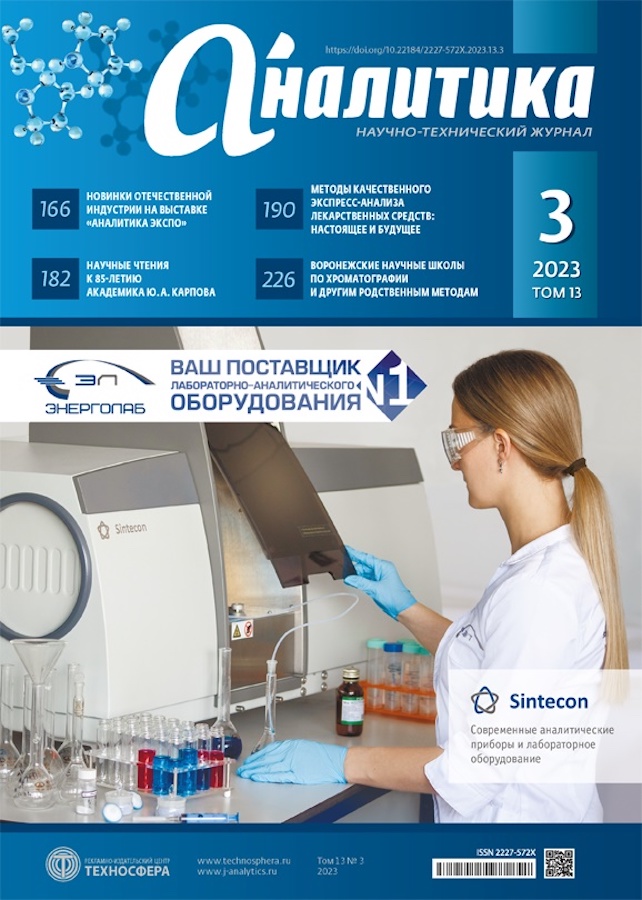Assessment of the Quality of Hydrochemical Information, Taking into Account Metrological Requirements
- Authors: Belousov R.A.1, Nazarova A.A.1, Rosenthal O.M.2
-
Affiliations:
- ФГБУ «Гидрохимический институт»
- Институт водных проблем РАН
- Issue: Vol 13, No 3 (2023)
- Pages: 220-225
- Section: Метрология химического анализа
- URL: https://journals.eco-vector.com/2227-572X/article/view/629379
- DOI: https://doi.org/10.22184/2227-572X.2023.13.3.220.225
- ID: 629379
Cite item
Abstract
The influence of measurement accuracy on the correctness of conclusions about the compliance of water quality with the established requirements is analyzed. It is shown that the error rates are 30% on average for common pollutants characteristic of drinking water and 40% for substances characteristic of natural waters. At the same time, the risk of false conclusions about the compliance / non-compliance of water with metrological requirements reaches 20-50% in the range from 0.9-1.2 MPC to 0.6-3.3 MPC at measurement error standards typical for common pollutants. The conclusion is made about the need for an optimal choice of methods and means for measuring hazardous substances, which guarantees an acceptable risk of false conclusions.
Full Text
About the authors
R. A. Belousov
ФГБУ «Гидрохимический институт»
Author for correspondence.
Email: r.belousov@gidrohim.com
Russian Federation
A. A. Nazarova
ФГБУ «Гидрохимический институт»
Email: r.belousov@gidrohim.com
к. х. н.
Russian FederationO. M. Rosenthal
Институт водных проблем РАН
Email: r.belousov@gidrohim.com
д. т. н.
Russian FederationReferences
- Данилов-Данильян В.И., Хранович И. Л. Гарантированное водопользование в рыночных условиях. Водные ресурсы. 2009;36(2):228–239.
- Никаноров А. М. Научные основы мониторинга качества вод. Гидрометеоиздат, С.Пб: 2005. 576 с.
- ГОСТ Р 8.563-2009. Государственная система обеспечения единства измерений. Методики (методы) измерений.
- ГОСТ 27384-2002. Вода. Нормы погрешности измерений показателей состава и свойств.
- МИ 1317-2004. Государственная система обеспечения единства измерений. Результаты и характеристики погрешности измерений. Формы представления. Способы использования при испытаниях образцов продукции и контроле их параметров.
- Белоусов Р. А., Назарова А. А., Розенталь О. М. Риск оценки соответствия качества воды установленным требованиям. АНАЛИТИКА. 2023; 13(2):126–130.
- СанПиН 1.2.3685-21. Гигиенические нормативы и требования к обеспечению безопасности и (или) безвредности для человека факторов среды обитания.
- ГОСТ 31858-2012. Вода питьевая. Метод определения содержания хлорорганических пестицидов газожидкостной хроматографией.
- РД 52.24.522-2009. Массовая концентрация хрома общего в водах. Методика выполнения измерений фотометрическим методом с дифенилкарбазидом.
- ГОСТ 31870-2012. Вода питьевая. Определение содержания элементов методами атомной спектрометрии.
- Информационный листок EURACHEM/CITAC: Применение информации о неопределенности измерения при оценке соответствия. Доступно на www.eurachem.org.
- ГОСТ Р 57554-2017. Охрана природы. Гидросфера. Учет показателей точности измерений контролируемых показателей при оценке соответствия качества воды установленным требованиям.
- Приказ Министерства сельского хозяйства Российской Федерации от 13.12.2016 № 552 «Об утверждении нормативов качества воды водных объектов рыбохозяйственного значения, в том числе нормативов предельно допустимых концентраций вредных веществ в водах водных объектов рыбохозяйственного значения» (Зарегистрирован 13.01.2017 № 45203).
- ГОСТ Р 51898-2002. Аспекты безопасности. Правила включения в стандарты.
Supplementary files











